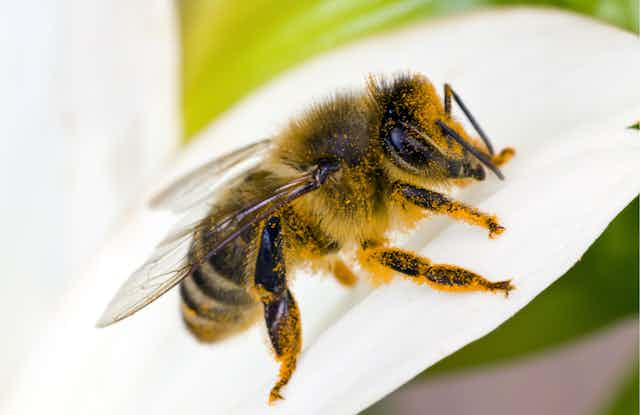The earliest forms of biological communication between single-celled organisms have survived evolution to exist in all species, including humans.
One of those conserved mechanisms enables insects to relay acquired information to their nest mates. The data gathering process is remarkably similar to that found in sensors commonly used in homes to detect human activity outside.
As a longtime academic whose research in recent years, in collaboration with an electronic engineer, has focused partly on sensors, I’ve been fascinated to explore how bees, like security sensors, process electric fields to monitor their environment.
(As an aside, a current, personal research project concerns another common mechanism that enables insects and humans to identify each of a vast multitude of environmental chemicals and odorants.)
Knowledge about feeding places, for example, can be relayed from honeybee to honeybee. The means of communication is a special dance of which there are two forms. An exhaustive, detailed analysis of the forager bee’s elaborate choreography is found in Karl von Frisch’s Nobel Lecture. The dance can be seen in this video:
The “round dance” provides the information that there is a feeding place in the vicinity of the beehive at a distance between 50 and 100 meters, without the particular direction being given. By way of close contact among the bees, it also supplies information about the type of food.
The “waggle dance” is used to relay information about more distant food sources. In order to do this, the dancing bee moves forward a certain distance on the vertically hanging honeycomb in the hive, then traces a half circle to return to her starting point, whereupon the dance begins again.
The other bees take in the information by keeping in close contact with the dancing bee and reconstructing its movements. They also receive information via their sense of smell about what is to be found at the food source (type of food, pollen, water) as well as its specific characteristics.
In a testament to nature’s consummate adaptations, among various species of honeybees there are choreographic dialects.
Modern technology provides more bee insight
Von Frisch made his observations a century ago. Only more recently, with the availability of sensitive instrumentation, has incisive knowledge been obtained into the manner in which information is both transmitted and received among bees.
Important clues into the mysterious manner in which the dance influences other bees arose from observations of some fish. By sensing remotely emitted electric fields, certain fish identify gender, age and other features of members within their own species and the presence of prey fish.
Recently, it was reported that bumblebees use the fine mechano-sensory hairs covering their bodies to detect weak electrical fields near the flowers they feed on and pollinate.

Dr. Gregory Sutton and his colleagues at the University of Bristol reported that the bees show preference for certain plants, indicating the identifying nature of the emitted electric field. As a bee approaches a flower, the floral electric field distorts the field around the bee’s body, and these distortions deflect the hairs, causing in them a lever-like movement that triggers the nerve cells at their base to fire off signals.
Tiny bee hairs act as antennae
Uwe Greggers of the Free University of Berlin measured the electric fields emanating from honeybees in various contexts, including during the waggle dance. The hairlike structures serve as antennae that receive the electric field signals, and are paired to nerve endings that transmit the substance-specific signals to the brain, where they are processed and stored.
Electric fields reflect the presence of matter; that means they’re everywhere. In a static environment, all exposed surfaces are in a balanced, charged electrostatic state. Introduction of a new substance or movement of an object or organism perturbs the electric field balance, eliciting a specific pattern of disturbance.
The propagating disturbance of the electric field is unimpeded by walls and barriers; the charge on one side of a wall is in balance with that on the other side.
All matter continuously generates electric fields, a manifestation of atomic structure; specifically, the number of electrons and their energies. Consequently, the electric field, reflecting the electron profile, is unique, i.e. a “fingerprint” for every atomic and molecular species.
Bees detect molecules by their electric field ‘fingerprints’
That’s at the heart of a bee’s ability to identify specific flowers and other entities. Security ‘cameras’, too, are electric field sensors and distinguish “fingerprints” of human motion, size, position and limb movements. They can be used to recognize the posture of infants in car seats and, through walls of various facilities, individuals in various positions and locations.
Insects in general are equipped with several tools to monitor their environments. Just one of these revealed by the bee is an electric field sensor.
A colleague and I have been developing an electric field sensor of our own long before we knew much about insect sensing. The assembly of our final instrument has relied markedly on features of the unassuming, high-tech bee.

